The French Revolution needs no introduction. It is one of the most iconic events in the world, not just in restructuring politics in Europe but also in shaping the art scene, and that’s why I’m sharing these French Revolution paintings with you today.
When we think of the French Revolution, we don’t just think of how France was on the brink of economic failure or how King Louis XVI and his wife, Marie Antoinette, faced death.
We also think about how the events inspired artists to create some of the best paintings the world has seen.
During this period, painting was a medium to tell the story of the rebellion and preserve history.
Also, many artists had to learn new artistic expressions and approaches, thus changing the art society forever. In this article, we look at some famous French Revolution paintings, the genius behind them, and what they symbolize.
12 Iconic French Revolution Paintings You Need to Know
1. Tennis Court Oath by Jacques-Louis David
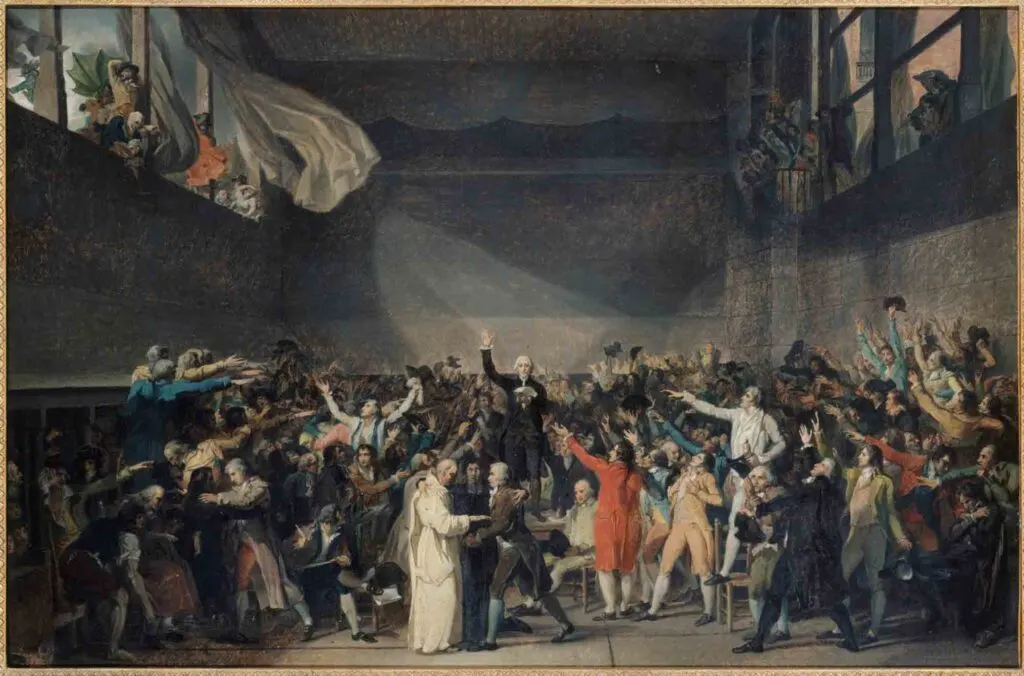
Jacques-Louis David’s comments on the French Revolution were evident in his unfinished painting that showed the moment when members of the Third Estate were taking the Tennis Court Oath in the 18th century.
The elected members of the Third Estate formed the National Assembly and one day gathered in the Tennis Court near the royal palace to take an oath to stay together until they had established a constitution.
This will become one of the founding events of the French Revolution.
Tennis Court Oath by Jacques-Louis David, a French painter, serves to preserve this moment in history when deputies of the nation took an oath together.
David paid attention to every detail so that every member who took the collective oath (and one who didn’t take it) could be identified from the painting.
A sad fact about this painting is that Jacques-Louis David couldn’t finish the artwork due to a lack of funding.
But the painting’s incompleteness made it even more meaningful after 1793 when most of the revolutionaries depicted in the artwork had fragmented and turned enemies of the revolution.
Where to see it: Musée national du Château de Versailles.
2. Liberty Leading The People by Eugène Delacroix
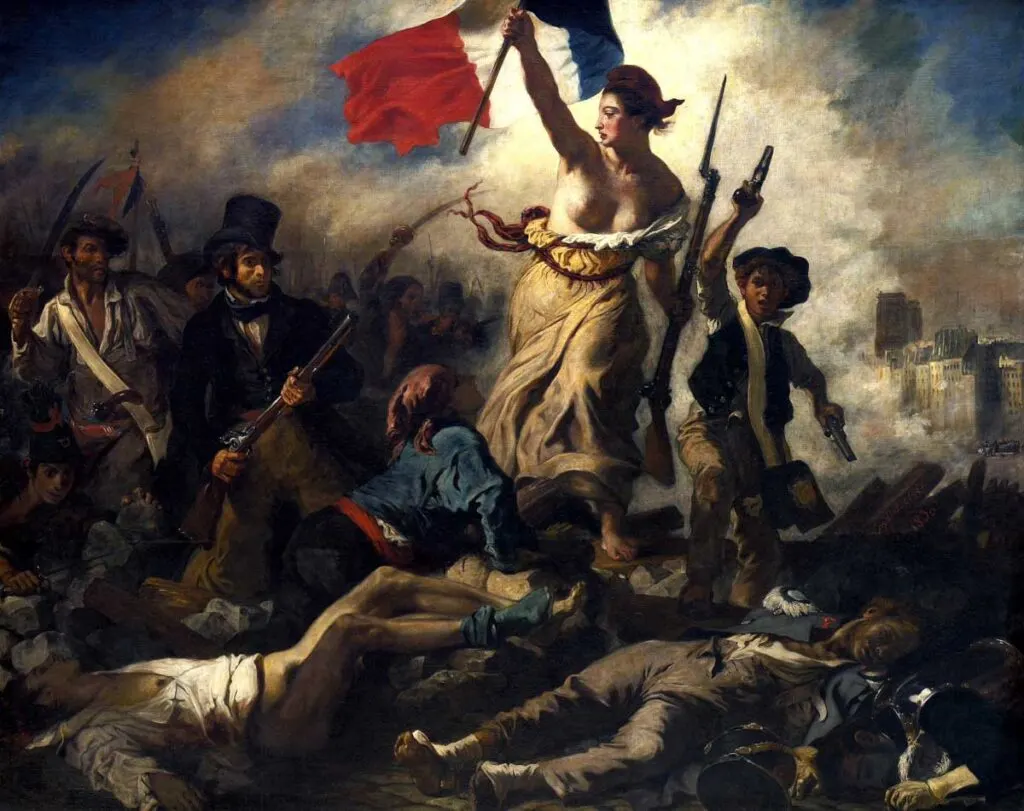
Eugène Delacroix, like many Romantic artists, was known for his fascination with revolutions and leaders.
One of his most famous French Revolution paintings, Liberty Leading the People, addresses the destiny of his country in the 19th century and brings to life the event that brought about the birth of a nation.
One of the interesting things about Delacroix’s painting is that it didn’t depict any scene from the revolution, unlike other French Revolution paintings.
Instead, it shows a personification of liberty (a bare-breasted woman) raising the tricolor French flag while marching over corpses, assumed to represent those who died during the fight for freedom.
The liberty figure was surrounded by revolutionaries of different classes, which critics said was the artist’s way of stressing how French people needed to unify to fight for a new nation.
In Delacroix’s view, the birth of a nation took the blood spillage and sacrifice of many people. Liberty Leading the People is regarded as one of the finest French Revolution paintings and one of the best arts in the Romanticist style.
Where to see it: Liberty Leading is one of the paintings in the Louvre Museum.
3. Marie-Antoinette Being Taken To Her Execution by William Hamilton

William Hamilton was a British artist intrigued by the French Revolution, especially the death of the mighty queen Marie Antoinette, one of the most famous French people.
In this painting, the extravagant queen was dressed in white, looking like a bride until you look at her face, which was stamped with sorrow.
The painting shows some soldiers dressed in black (a contrast to her white dress!) and ready to take the queen to her execution while holding back her crown.
Perhaps the most interesting thing about this painting is the fact that the former queen looked like she was resigned to her fate, accepting that nothing could save her from the rage of her jailers.
Where to see it: Museum of the French Revolution.
4. Representation of the Declaration of the Rights of the Man and Citizen by Jean-Jacques-François Le Barbier
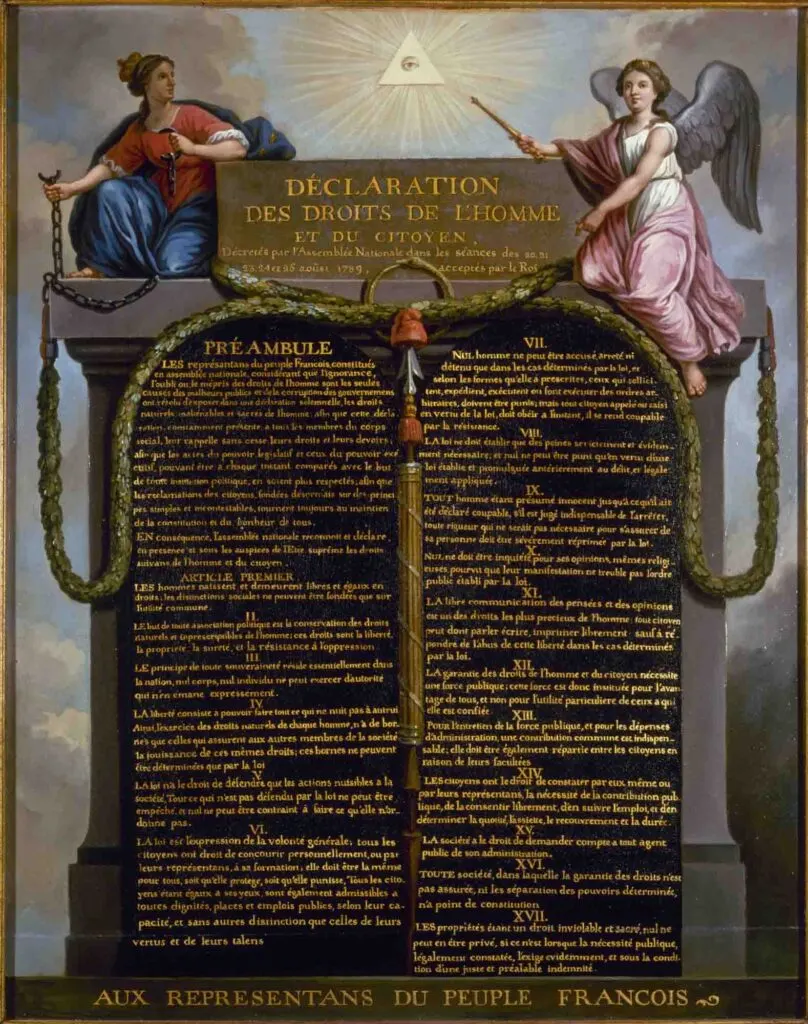
This French painting was inspired and named after the revolutionary document developed by the new regime in 1789.
This document was printed at the time of the declaration to spread the message of the core values of the revolution throughout the country.
It was also designed to be hung in public places so people could see what the Assembly was doing. Le Barbier’s famous work represented this document, The Declaration of the Rights of Man and the Citizen.
It’s also interesting to note that Le Barbier was an official court painter for King Louis XVI before the revolution.
Where to see it: Musée Carnavalet.
5. The Storming Of The Bastille by Jean-Baptiste Lallemand

Jean-Baptiste Lallemand specialized in landscape painting, and his famous work, The Storming of the Bastille, recorded the turbulent period in French history.
Here is a little historical story: On July 14th, 1789, France saw the fall of the Bastille after a crowd stormed the prison fortress where the French King incarcerated those who opposed his monarchy. The 14th of July is now a national holiday in France known as Bastille Day.
Bastille represented the oppressive nature of the monarchy, and its storming led to the beginning of the French Revolution.
The Storming of the Bastille serves as a visual record of this pivotal moment in history, showcasing the fall of the fortress through Jean-Baptiste’s eyes as a survivor of the Revolution.
What makes this painting special is its lack of grandeur. For example, you can not make out any detailed faces from the painting; there is no protagonist or main character.
Instead, we see confused figures lost in action and partaking fiercely in a battle with the Bastille in the background.
People have mentioned that this is one of the French Revolution paintings that shows the suffering and violence that went into getting the Monarchy out of power.
There is something just beautiful about the messy representation of the Revolution rather than the polished version depicted by other paintings of the French Revolution.
Where to see it: Musée Carnavalet Paris.
6. Une Exécution Capitale, place de la Révolution by Pierre-Antoine Demachy

Pierre-Antoine Demachy was a regarded artist even before the French Revolution, and his work focused on ancient ruins and architecture.
Demachy added to the French Revolution art through some paintings, but one of the most powerful is Une exècution capitale. This painting depicts the La Place de la Concorde, a public square in the capital of France that experienced significant events of the revolution.
Une Exècution capitale was painted in 1793 during the early days of the Reign of Terror and shows the execution of a counter-revolutionary at the public square while a happy crowd surrounded the guillotine.
One thing of interest is that the public square was used for the wedding celebration of Louis XVI and Antoinette.
During the event, a firework accident happened, killing about 3,000 members of the audience. Some years later, Louis XVI and Antoinette were both executed in the same public square, and this site would see many more executions.
Where to see it: Musée Carnavalet Paris.
7. The Death Of Marat by Jaques-Louis David
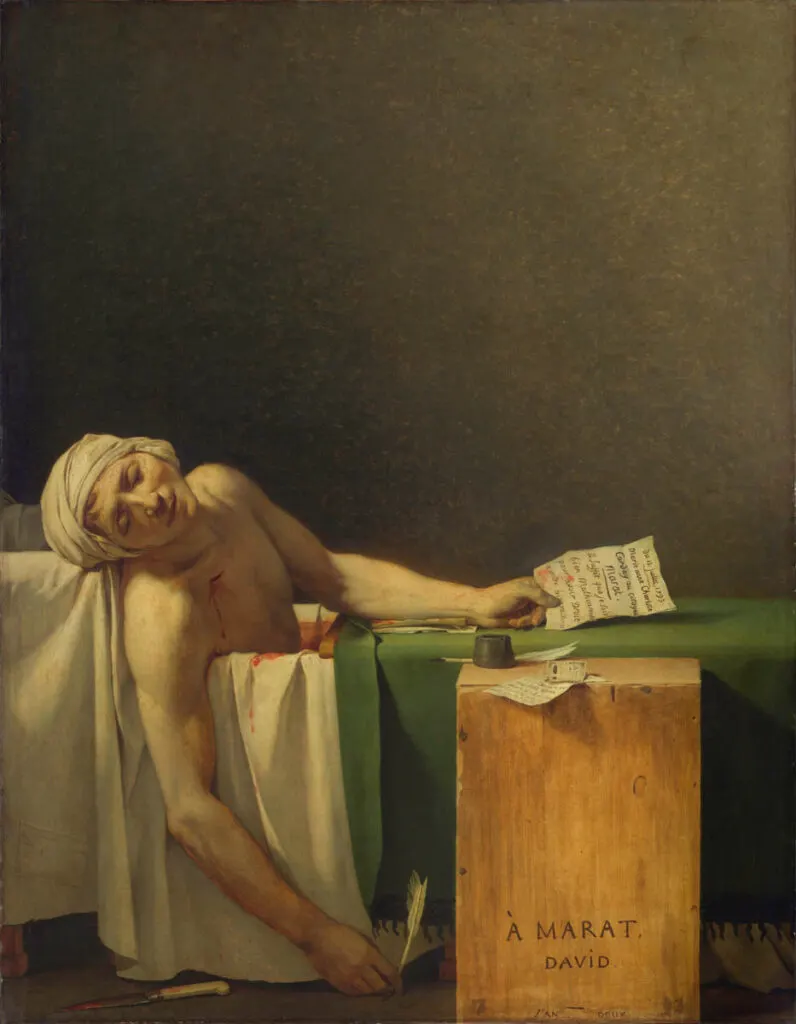
Painted in 1793 by Jaques-Louis David, The Death of Marat depicts the Jacobin leader, Marat, lying in blood, taking his final breaths in a covered bathtub while holding onto a piece of an unfinished letter.
This painting symbolizes the assassination of Jean-Paul Marat in July 1793 after he was accused of being involved in the Reign of Terror, which witnessed the execution of over 15,000 people.
According to the story, a lady stabbed Marat to death while he was working on a publication in his bathroom.
Marat was famous for writing revolutionary messages in publications, and his death made the political situation more gruesome so that anyone considered counterrevolutionary was executed without a trial.
David portrayed Marat in this painting as some Christian martyr with light distributed across his body. At the same time, the bathroom was relegated to a dark abyss so that it focused on his body.
Christian paintings often portrayed martyrs in a holy glow, so it was said David borrowed from this painting style to depict Marat as a new saint of a new political order.
Where to see it: Musée Oldmasters Museum.
8. Marie Antoinette with the Rose by Élisabeth Louise Vigée le Brun
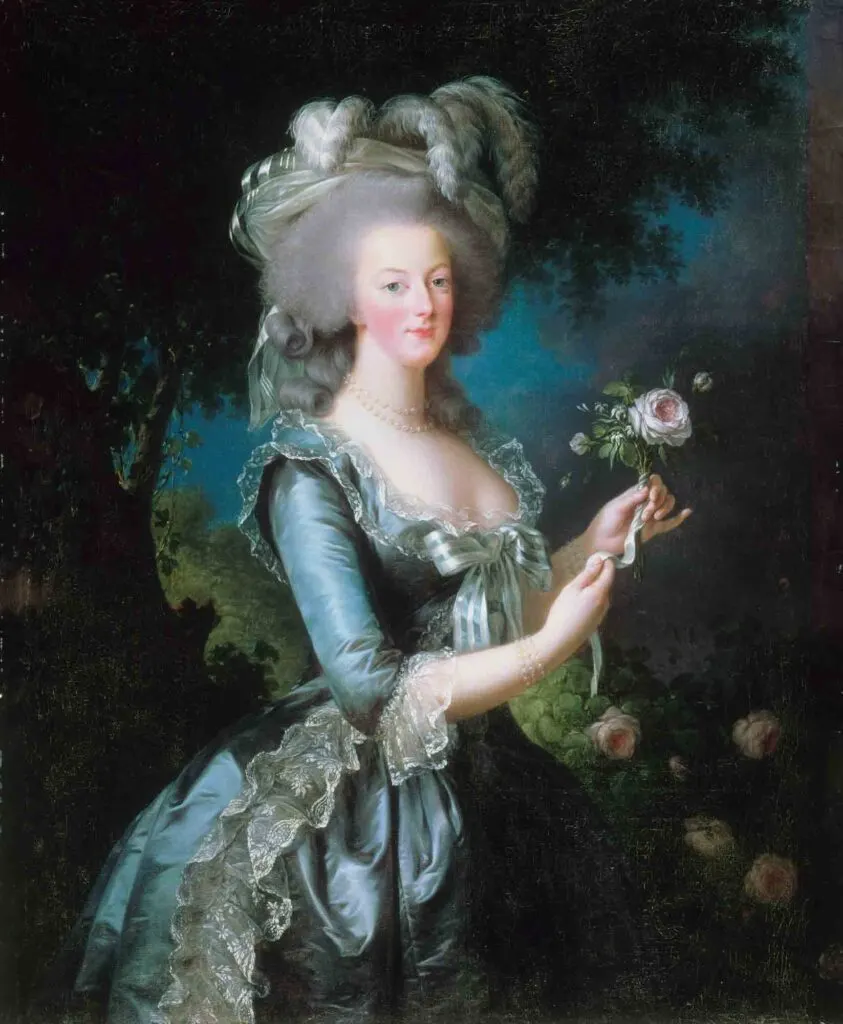
Marie Antoinette, Queen of France, lived a decadent lifestyle, and in this painting, she was wearing a luxurious silk dress while holding a rose.
The queen commissioned Elisabeth Louise Le Brun to make a portrait of her for the Salon that year, and she initially made a portrait of the queen in a chemise, a rural dress.
The organizers where Le Brun wanted to present the painting found the outfit insulting for a queen of France, so they withdrew it from the Salon.
To address this criticism and get her work accepted, Le Brun painted Marie Antoinette with the rose, a piece received in celebrations.
The second painting portrayed Antoinette exactly as she was: an extravagant queen out of touch with the reality of the citizens.
Where to see it: Palace of Versailles.
9. The Lictors Bring to Brutus the Bodies of His Sons by Jacques-Louis David
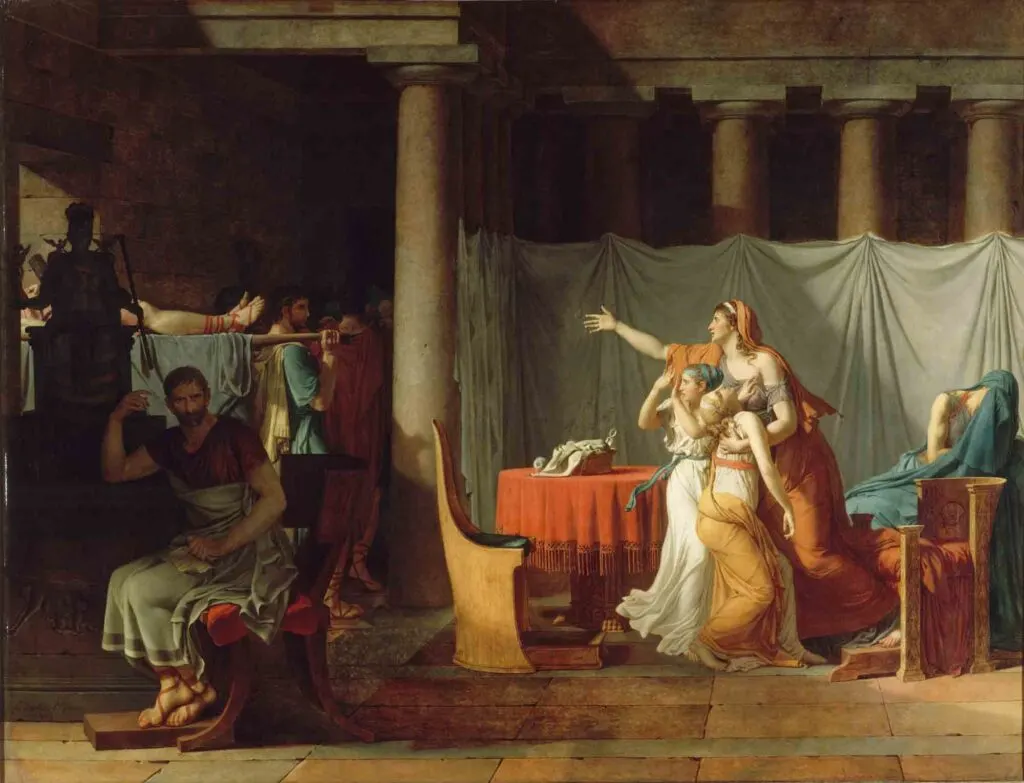
Some of the most famous French Revolutionary paintings were made by Jacques-Louis David, an ambitious artist who aspired to fame by painting noble and heroic figures.
This painting shows an important subject from Rome’s past, Brutus, but the scene in the painting was most likely invented as there is no evidence of it happening.
The scene depicts the aftermath of the execution of the sons of Lucius Junius Brutus after they planned to restore the overthrown monarchy.
The punishment for this was execution, and to serve as a good example, Brutus ordered the execution of his own sons.
There is one thing vague about this painting: Brutus had an unexpressive demeanor, so you couldn’t tell whether he was satisfied with choosing the preservation of his nation over his family.
Brutus wasn’t the only character in this artwork; there was also his wife and daughters who appeared fragmented from him. They looked shocked and sad, and a nursemaid hid her head in dismay.
Where to see it: Louvre Museum.
10. Portrait of a Revolutionary by Jean-François Sablet
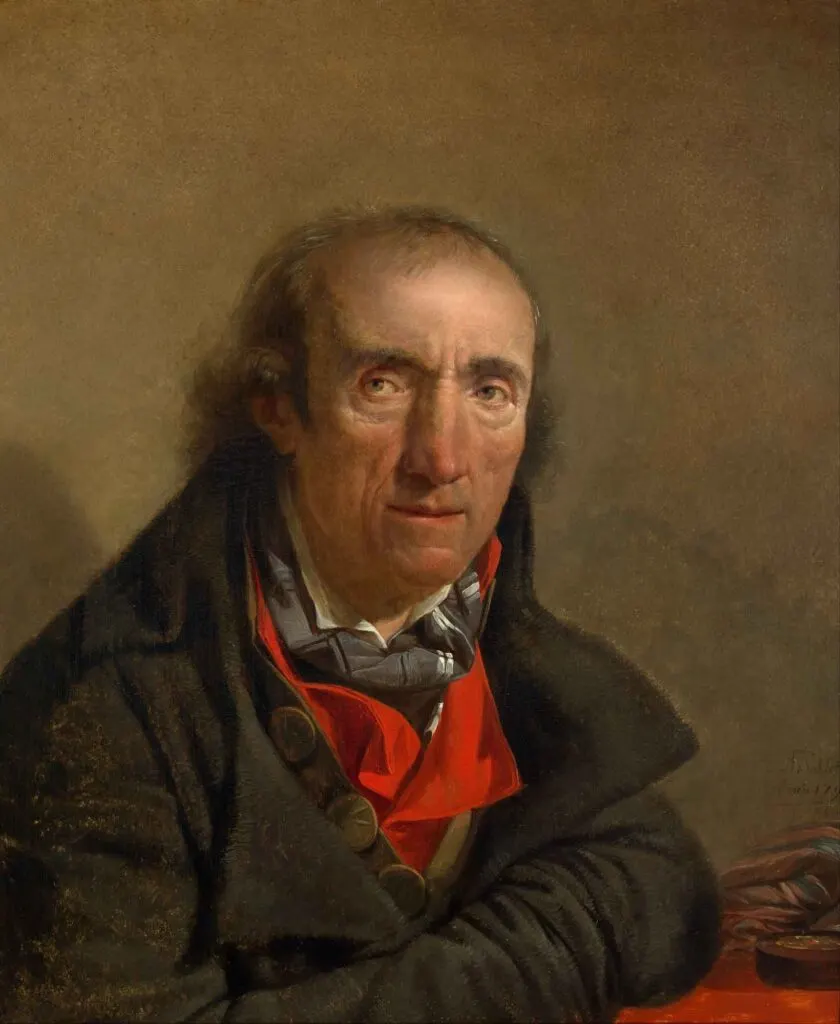
Jean-Francois Sablet produced a number of portraits during the Revolution, including one by Joseph-Agricol Viala and Lycurgus.
This particular painting, dated 1784, displayed a portrait of an older man. The unidentified old man showed signs of revolution with his red, white, and blue waistcoat, cravat, and a round box containing a badge of office/cockade.
During the French Revolution, many young Frenchmen were enlisted for military service, leaving older generations to serve as home guards and other civic duties.
The sitter of this portrait was an officer of the local government at the Municipalité.
One of the highlights of this painting was how Sablet was able to portray the state of the French government through the features of the old man in the portrait.
The man has a serious demeanor and sunken eyes that somehow represent the terror and bloodshed that had begun at that time.
Where to see it: National Gallery of Victoria.
11. Napoleon at the St. Bernard Pass / Napoleon Crossing the Alps by Jacques-Louis David

Napoleon Crossing the Alps was painted between 1801 and 1805 by Jacques-Louis David to commemorate the crossing of the St. Bernard pass by the army reserve in May 1800.
After years of tumultuous events, France was edging towards a new century with General Napoleon at the front run. He had become the First Consul after staging a successful coup d’etat against the revolutionary government.
Also, the event that led to this painting was him leading his troops across the Alps in a military campaign against the Austrians at the Battle of Marengo.
His achievement was depicted in the painting with him on a horse and wearing his uniform at the Battle of Marengo.
This French painting was supposed to be a proper portrait of Napoleon, but Jacques-Louis David mentioned that the powerful man offered little support during the painting process.
For example, Napoleon refused to sit for the portrait, so David had to seek inspiration from an earlier portrait of him. However, Napoleon was the one who suggested the idea of having him on a fiery horse to demonstrate his strength and composure.
Napoleon Crossing the Alps remains one of the most popular portraits of Napoleon Bonaparte and was commissioned by the then King of Spain, Charles IV.
Where to see it: Châteaux de Malmaison.
12. Demolition of the Chateau Meudon by Hubert Robert

Huberty Robert narrowly escaped execution during the revolutionary regime due to his apolitical stance, and yet he contributed to the body of French Revolution paintings.
Robert, also known as Robert of the Ruins due to his love for painting ruins, spent 11 years in Rome, perfecting his skills and becoming well-versed in Romanticism.
In the Demolition of the Chateau Meudon, Robert painted the Chateau of Meudon under a sun-drenched sky.
This site served as the royal residence and was one of the finest French monuments until it was ransacked and demolished during the revolution.
Robert was praised for his capriccio skill in this painting, for he could integrate features of the Chateau that no longer existed.
Rather than document the site’s demolished state, Robert painted the Chateau as slightly ruined, thus blending fact and fiction to depict the former importance of the building.
Where to see it: Getty Center in LA.
Don’t Forget About Travel Insurance!
Before you leave for France, make sure you have a valid travel insurance policy because accidents happen on the road. We have been paying for Safety Wing travel insurance for a little over a year now, and we happily recommend them to our family and friends.
If you get sick, injured, or have your stuff stolen, you'll be happy to have the ability to pay for your medical bills or replace what was stolen.
Because, for just a couple of dollars a day (depending on how long your policy is for), you're going to get lots of things covered. Be smart and get travel insurance.
